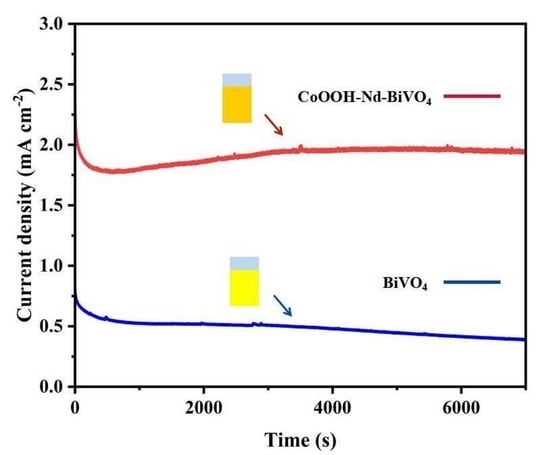Doping with Rare Earth Elements and Loading Cocatalysts to Improve the Solar Water Splitting Performance of BiVO4
Abstract
1. Introduction
2. Results and Discussion
3. Experimental Section
3.1. Preparation of BiVO4 and Nd-BiVO4 Photoanodes
3.2. Preparation of CoOOH-Nd-BiVO4 Photoanode
4. Conclusions
Supplementary Materials
Author Contributions
Funding
Data Availability Statement
Conflicts of Interest
References
- Zou, X.; Sun, Z.; Hu, Y.H. g-C3N4-based photoelectrodes for photoelectrochemical water splitting: A review. J. Mater. Chem. A 2020, 8, 21474–21502. [Google Scholar] [CrossRef]
- Marwat, M.A.; Humayun, M.; Afridi, M.W.; Zhang, H.; Abdul Karim, M.R.; Ashtar, M.; Usman, M.; Waqar, S.; Ullah, H.; Wang, C.; et al. Advanced Catalysts for Photoelectrochemical Water Splitting. ACS Appl. Energy Mater. 2021, 4, 12007–12031. [Google Scholar] [CrossRef]
- Peru, F.; Payandeh, S.; Jensen, T.R.; Charalambopoulou, G.; Steriotis, T. Destabilization of the LiBH4-NaBH4 Eutectic Mixture through Pore Confinement for Hydrogen Storage. Inorganics 2023, 11, 128. [Google Scholar] [CrossRef]
- Chowdhury, P.; Malekshoar, G.; Ray, A.K. Dye-Sensitized Photocatalytic Water Splitting and Sacrificial Hydrogen Generation: Current Status and Future Prospects. Inorganics 2017, 5, 34. [Google Scholar] [CrossRef]
- Wang, S.; He, T.; Chen, P.; Du, A.; Ostrikov, K.K.; Huang, W.; Wang, L. In Situ Formation of Oxygen Vacancies Achieving Near-Complete Charge Separation in Planar BiVO4 Photoanodes. Adv. Mater. 2020, 32, e2001385. [Google Scholar] [CrossRef]
- Zhou, Z.; Chen, J.; Wang, Q.; Jiang, X.; Shen, Y. Enhanced photoelectrochemical water splitting using a cobalt-sulfide-decorated BiVO4 photoanode. Chin. J. Catal. 2022, 43, 433–441. [Google Scholar] [CrossRef]
- Yu, J.M.; Lee, J.; Kim, Y.S.; Song, J.; Oh, J.; Lee, S.M.; Jeong, M.; Kim, Y.; Kwak, J.H.; Cho, S.; et al. High-performance and stable photoelectrochemical water splitting cell with organic-photoactive-layer-based photoanode. Nat. Commun. 2020, 11, 5509. [Google Scholar] [CrossRef]
- Jiang, W.; An, Y.; Wang, Z.; Wang, M.; Bao, X.; Zheng, L.; Cheng, H.; Wang, P.; Liu, Y.; Zheng, Z.; et al. Stress-induced BiVO4 photoanode for enhanced photoelectrochemical performance. Appl. Catal. B Environ. 2022, 304, 121012. [Google Scholar] [CrossRef]
- Blakemore, J.D.; Crabtree, R.H.; Brudvig, G.W. Molecular Catalysts for Water Oxidation. Chem. Rev. 2015, 115, 12974–13005. [Google Scholar] [CrossRef]
- Kuang, Y.; Yamada, T.; Domen, K. Surface and Interface Engineering for Photoelectrochemical Water Oxidation. Joule 2017, 1, 290–305. [Google Scholar] [CrossRef]
- Pan, J.B.; Shen, S.; Chen, L.; Au, C.T.; Yin, S.F. Core–Shell Photoanodes for Photoelectrochemical Water Oxidation. Adv. Funct. Mater. 2021, 31, 210426. [Google Scholar] [CrossRef]
- Song, K.; Hou, H.; Zhang, D.; He, F.; Yang, W. In-situ cation-exchange strategy for engineering single-atomic Co on TiO2 photoanode toward efficient and durable solar water splitting. Appl. Catal. B Environ. 2023, 330, 122630. [Google Scholar] [CrossRef]
- Ma, W.; Huang, K.; Wu, X.; Wang, M.; Feng, S. Surface polarization enables high charge separation in TiO2 nanorod photoanode. Nano. Res. 2021, 14, 4056–4062. [Google Scholar] [CrossRef]
- Kim, H.Y.; Kong, H.; Kim, J.H.; Yang, W.-G.; Lee, H.; Ko, S.; Lee, H.J.; Piao, G.; Park, H.; Chae, W.-S.; et al. Laser-induced deposition of Ni, Co-doped FeOOH cocatalysts on WO3 photoanodes and elucidating their roles in water oxidation in terms of carrier dynamics. J. Mater. Chem. A 2023, 11, 4598–4607. [Google Scholar] [CrossRef]
- Kalanur, S.S.; Singh, R.; Seo, H. Enhanced solar water splitting of an ideally doped and work function tuned {002} oriented one-dimensional WO3 with nanoscale surface charge mapping insights. Appl. Catal. B Environ. 2021, 295, 120269. [Google Scholar] [CrossRef]
- Chai, H.; Wang, S.; Wang, X.; Ma, J.; Jin, J. Modulation of the Chemical Microenvironment at the Hematite-Based Photoanode Interface with a Covalent Triazine Framework for Efficient Photoelectrochemical Water Oxidation. ACS Catal. 2022, 12, 3700–3709. [Google Scholar] [CrossRef]
- Jeon, T.H.; Bokare, A.D.; Han, D.S.; Abdel-Wahab, A.; Park, H.; Choi, W. Dual modification of hematite photoanode by Sn-doping and Nb2O5 layer for water oxidation. Appl. Catal. B Environ. 2017, 201, 591–599. [Google Scholar] [CrossRef]
- Lee, Y.; Kim, S.; Jeong, S.Y.; Seo, S.; Kim, C.; Yoon, H.; Jang, H.W.; Lee, S. Surface-Modified Co-doped ZnO Photoanode for Photoelectrochemical Oxidation of Glycerol. Catal. Today 2021, 359, 43–49. [Google Scholar] [CrossRef]
- Zhang, B.; Wang, Z.; Huang, B.; Zhang, X.; Qin, X.; Li, H.; Dai, Y.; Li, Y. Anisotropic Photoelectrochemical (PEC) Performances of ZnO Single-Crystalline Photoanode: Effect of Internal Electrostatic Fields on the Separation of Photogenerated Charge Carriers during PEC Water Splitting. Chem. Mater. 2016, 28, 6613–6620. [Google Scholar] [CrossRef]
- Gao, L.; Long, X.; Wei, S.; Wang, C.; Wang, T.; Li, F.; Hu, Y.; Ma, J.; Jin, J. Facile growth of AgVO3 nanoparticles on Mo-doped BiVO4 film for enhanced photoelectrochemical water oxidation. Chem. Eng. J. 2019, 378, 122193. [Google Scholar] [CrossRef]
- Huang, Q.; Qiu, Y.; Luo, H.; Yuan, Y.; Li, X.; Wang, Z.; Mai, W. p-Type NiO modified BiVO4 photoanodes with enhanced charge separation and solar water oxidation kinetics. Mater. Lett. 2019, 249, 128–131. [Google Scholar] [CrossRef]
- Liu, Z.; Wang, Y.; Wang, B.; Li, Y.; Liu, Z.; Han, J.; Guo, K.; Li, Y.; Cui, T.; Han, L.; et al. PEC electrode of ZnO nanorods sensitized by CdS with different size and its photoelectric properties. Int. J. Hydrogen Energy 2013, 38, 10226–10234. [Google Scholar] [CrossRef]
- Tayebi, M.; Kolaei, M.; Tayyebi, A.; Masoumi, Z.; Belbasi, Z.; Lee, B.-K. Reduced graphene oxide (RGO) on TiO2 for an improved photoelectrochemical (PEC) and photocatalytic activity. Sol. Energy 2019, 190, 185–194. [Google Scholar] [CrossRef]
- Chen, Y.; Liu, L.; Zhang, L.; Li, S.; Zhang, X.; Yu, W.; Wang, F.; Xue, W.; Wang, H.; Bian, Z. Construction of Z-type heterojunction BiVO4/Sm/α-Fe2O3 photoanode for selective degradation: Efficient removal of bisphenol A based on multifunctional Sm-doped modification. Appl. Catal. B Environ. 2023, 333, 122775. [Google Scholar] [CrossRef]
- Zheng, G.; Wang, J.; Zu, G.; Che, H.; Lai, C.; Li, H.; Murugadoss, V.; Yan, C.; Fan, J.; Guo, Z. Sandwich structured WO3 nanoplatelets for highly efficient photoelectrochemical water splitting. J. Mater. Chem. A 2019, 7, 26077–26088. [Google Scholar] [CrossRef]
- Zhang, Y.; Zhao, X.; Wang, H.; Fu, S.; Lv, X.; He, Q.; Liu, R.; Ji, F.; Xu, X. Effect of Temperature on the Adhesion and Bactericidal Activities of Ag+-Doped BiVO4 Ceramic Tiles. Inorganics 2022, 10, 61. [Google Scholar] [CrossRef]
- Sriwichai, S.; Irani, R.; Xi, F.; Friedrich, D.; Höhn, C.; Ahmet, I.Y.; Wetchakun, N.; Abdi, F.F. Role of Gd in Enhancing the Charge Carrier Mobility of Spray–Deposited BiVO4 Photoanodes. Sol. RRL 2021, 5, 2100268. [Google Scholar] [CrossRef]
- Martinez Suarez, C.; Hernández, S.; Russo, N. BiVO4 as photocatalyst for solar fuels production through water splitting: A short review. Appl. Catal. A Gen. 2015, 504, 158–170. [Google Scholar] [CrossRef]
- Wu, L.; Wang, M.; Han, T.; Yang, B.; Geng, L.; Jin, J. Fabrication of Fe2O3/BiVO4 heterojunction by doping method to improve the solar water splitting performance of BiVO4. J. Alloys Compd. 2023, 949, 169822. [Google Scholar] [CrossRef]
- Zeng, G.; Deng, Y.; Yu, X.; Zhu, Y.; Fu, X.; Zhang, Y. Ultrathin g-C3N4 as a hole extraction layer to boost sunlight-driven water oxidation of BiVO4-Based photoanode. J. Power Sources 2021, 494, 229701. [Google Scholar] [CrossRef]
- Wang, S.; Chen, P.; Yun, J.H.; Hu, Y.; Wang, L. An Electrochemically Treated BiVO4 Photoanode for Efficient Photoelectrochemical Water Splitting. Angew. Chem. Int. Ed. Engl. 2017, 56, 8500–8504. [Google Scholar] [CrossRef]
- Deng, Y.; Fu, X.; Zhang, Y.; Zhu, Y.; Wei, Y. Efficient Oxygen Evolution Reaction on Polyethylene Glycol-Modified BiVO4 Photoanode by Speeding up Proton Transfer. Small 2022, 18, e2201410. [Google Scholar] [CrossRef]
- Yang, L.; Xiong, Y.; Guo, W.; Guo, J.; Gao, D.; Zhang, Y.; Xiao, P. Mo6+ Doped BiVO4 with improved Charge Separation and Oxidation Kinetics for Photoelectrochemical Water Splitting. Electrochim. Acta 2017, 256, 268–277. [Google Scholar] [CrossRef]
- Kubendhiran, S.; Chung, R.-J.; Yougbaré, S.; Lin, L.-Y.; Wu, Y.-F. Enhanced photoelectrochemical water oxidation on BiVO4 by addition of ZnCo-MOFs as effective hole transfer co-catalyst. Int. J. Hydrogen Energy 2023, 48, 101–112. [Google Scholar] [CrossRef]
- Lai, C.C.; Chen, J.W.; Chang, J.C.; Kuo, C.Y.; Liu, Y.C.; Yang, J.C.; Hsieh, Y.T.; Tseng, S.W.; Pu, Y.C. Two-Step Process of a Crystal Facet-Modulated BiVO4 Photoanode for Efficiency Improvement in Photoelectrochemical Hydrogen Evolution. ACS Appl. Mater. Interfaces 2022, 14, 24919–24928. [Google Scholar] [CrossRef]
- Quiñonero, J.; Lana–Villarreal, T.; Gómez, R. Improving the photoactivity of bismuth vanadate thin film photoanodes through doping and surface modification strategies. Appl. Catal. B Environ. 2016, 194, 141–149. [Google Scholar] [CrossRef]
- Qiao, Y.; Schelter, E.J. Lanthanide Photocatalysis. Acc. Chem. Res. 2018, 51, 2926–2936. [Google Scholar] [CrossRef]
- Bünzli, J.-C.G. Lanthanide Photonics: Shaping the Nanoworld. Trends Chem. 2019, 1, 751–762. [Google Scholar] [CrossRef]
- Zhang, A.; Zhang, J. Effects of europium doping on the photocatalytic behavior of BiVO4. J. Hazard. Mater. 2010, 173, 265–272. [Google Scholar] [CrossRef]
- Zhao, K.; Liu, X.; He, Q.; Zhou, W.; Yang, K.; Tao, L.; Li, F.; Yu, C. Preparation and characterization of Sm3+/Tm3+ co-doped BiVO4 micro-squares and their photocatalytic performance for CO2 reduction. J. Taiwan Inst. Chem. E. 2023, 144, 104737. [Google Scholar] [CrossRef]
- Yao, N.; Huang, J.; Fu, K.; Deng, X.; Ding, M.; Zhang, S.; Xu, X.; Li, L. Reduced interfacial recombination in dye-sensitized solar cells assisted with NiO:Eu3+,Tb3+ coated TiO2 film. Sci. Rep. 2016, 6, 31123. [Google Scholar] [CrossRef]
- Liu, T.; Tan, G.; Zhao, C.; Xu, C.; Su, Y.; Wang, Y.; Ren, H.; Xia, A.; Shao, D.; Yan, S. Enhanced photocatalytic mechanism of the Nd-Er co-doped tetragonal BiVO4 photocatalysts. Appl. Catal. B Environ. 2017, 213, 87–96. [Google Scholar] [CrossRef]
- Luo, Y.; Tan, G.; Dong, G.; Zhang, L.; Huang, J.; Yang, W.; Zhao, C.; Ren, H. Structural transformation of Sm3+ doped BiVO4 with high photocatalytic activity under simulated sun-light. Appl. Surf. Sci. 2015, 324, 505–511. [Google Scholar] [CrossRef]
- Prasad, U.; Prakash, J.; Gupta, S.K.; Zuniga, J.; Mao, Y.; Azeredo, B.; Kannan, A.N.M. Enhanced Photoelectrochemical Water Splitting with Er- and W-Codoped Bismuth Vanadate with WO3 Heterojunction-Based Two-Dimensional Photoelectrode. ACS Appl. Mater. Interfaces 2019, 11, 19029–19039. [Google Scholar] [CrossRef] [PubMed]
- Wang, S.; He, T.; Yun, J.H.; Hu, Y.; Xiao, M.; Du, A.; Wang, L. New Iron-Cobalt Oxide Catalysts Promoting BiVO4 Films for Photoelectrochemical Water Splitting. Adv. Funct. Mater. 2018, 28, 1802685. [Google Scholar] [CrossRef]
- Kaur, M.; Chhetri, M.; Rao, C.N.R. Photoelectrochemical OER activity by employing BiVO4 with manganese oxide co-catalysts. Phys. Chem. Chem. Phys. 2020, 22, 811–817. [Google Scholar] [CrossRef] [PubMed]
- Zhang, R.; Ning, X.; Wang, Z.; Zhao, H.; He, Y.; Han, Z.; Du, P.; Lu, X. Significantly Promoting the Photogenerated Charge Separation by Introducing an Oxygen Vacancy Regulation Strategy on the FeNiOOH Co-Catalyst. Small 2022, 18, e2107938. [Google Scholar] [CrossRef]
- Yang, Y.; Wan, S.; Li, S.; Wang, R.; Ou, M.; Liu, B.; Zhong, Q. A large size BiVO4 photoanode with high stability for efficient water oxidation and wastewater treatment coupled with H2 evolution. J. Mater. Chem. A 2023, 11, 1756–1765. [Google Scholar] [CrossRef]
- She, H.; Yue, P.; Huang, J.; Wang, L.; Wang, Q. One-step hydrothermal deposition of F:FeOOH onto BiVO4 photoanode for enhanced water oxidation. Chem. Eng. J. 2020, 392, 123703. [Google Scholar] [CrossRef]
- Peng, Y.; Du, M.; Zou, X.; Jia, G.; Permatasari Santoso, S.; Peng, X.; Niu, W.; Yuan, M.; Hsu, H.Y. Suppressing photoinduced charge recombination at the BiVO4||NiOOH junction by sandwiching an oxygen vacancy layer for efficient photoelectrochemical water oxidation. J. Colloid Interface Sci. 2022, 608, 1116–1125. [Google Scholar] [CrossRef]
- Kang, Z.; Sun, Z.; Zang, Y.; Wan, S.; Zheng, Y.-Z.; Tao, X. Dual functions of heterometallic FeCo oxyhydroxides in borate-treated BiVO4 photoanodes toward boosted activity and photostability in photoelectrochemical water oxidation. Chem. Eng. J. 2022, 431, 133379. [Google Scholar] [CrossRef]
- Wu, J.-M.; Chen, Y.; Pan, L.; Wang, P.; Cui, Y.; Kong, D.; Wang, L.; Zhang, X.; Zou, J.-J. Multi-layer monoclinic BiVO4 with oxygen vacancies and V4+ species for highly efficient visible-light photoelectrochemical applications. Appl. Catal. B Environ. 2018, 221, 187–195. [Google Scholar] [CrossRef]
- Li, Y.; Wang, Q.; Hu, X.; Meng, Y.; She, H.; Wang, L.; Huang, J.; Zhu, G. Constructing NiFe-metal-organic frameworks from NiFe-layered double hydroxide as a highly efficient cocatalyst for BiVO4 photoanode PEC water splitting. Chem. Eng. J. 2022, 433, 133592. [Google Scholar] [CrossRef]
- Tian, K.; Wu, L.; Yang, B.; Chai, H.; Gao, L.; Wang, M.; Jin, J. Anchored lithium-rich manganese nanoparticles boosting Nd-BiVO4 photoanode for efficient solar-driven water splitting. Colloids Surf. A Physicochem. Eng. Asp. 2023, 662, 130976. [Google Scholar] [CrossRef]
- Yalavarthi, R.; Zbořil, R.; Schmuki, P.; Naldoni, A.; Kment, Š. Elucidating the role of surface states of BiVO4 with Mo doping and a CoOOH co-catalyst for photoelectrochemical water splitting. J. Power Sources 2021, 483, 229080. [Google Scholar] [CrossRef]
- Zhao, F.; Li, N.; Wu, Y.; Wen, X.; Zhao, Q.; Liu, G.; Li, J. BiVO4 photoanode decorated with cobalt-manganese layered double hydroxides for enhanced photoelectrochemical water oxidation. Int. J. Hydrogen Energy 2020, 45, 31902–31912. [Google Scholar] [CrossRef]
- Tian, K.; Wu, L.; Han, T.; Gao, L.; Wang, P.; Chai, H.; Jin, J. Dual modification of BiVO4 photoanode by rare earth element neodymium doping and further NiFe2O4 co-catalyst deposition for efficient photoelectrochemical water oxidation. J. Alloys Compd. 2022, 923, 166352. [Google Scholar] [CrossRef]
- Gao, X.; Wang, Z.; Zhai, X.; Fu, F.; Li, W. The synthesize of lanthanide doped BiVO4 and its enhanced photocatalytic activity. J. Mol. Liq. 2015, 211, 25–30. [Google Scholar] [CrossRef]
- Luo, Y.; Tan, G.; Dong, G.; Ren, H.; Xia, A. Effects of structure, morphology, and up-conversion on Nd-doped BiVO4 system with high photocatalytic activity. Ceram. Int. 2015, 41, 3259–3268. [Google Scholar] [CrossRef]
- Tang, F.; Cheng, W.; Su, H.; Zhao, X.; Liu, Q. Smoothing Surface Trapping States in 3D Coral-Like CoOOH-W rapped-BiVO4 for Efficient Photoelectrochemical Water Oxidation. ACS Appl. Mater. Interfaces 2018, 10, 6228–6234. [Google Scholar] [CrossRef]
- Yang, P.; Shi, H.; Wu, H.; Yu, D.; Huang, L.; Wu, Y.; Gong, X.; Xiao, P.; Zhang, Y. Manipulating the surface states of BiVO4 through electrochemical reduction for enhanced PEC water oxidation. Nanoscale 2023, 15, 4536–4545. [Google Scholar] [CrossRef] [PubMed]
- Han, T.; Wu, L.; Wang, M.; Gao, L.; Long, X.; Liang, J.; Yang, B.; Jin, J. A novel co-catalyst of CoFeOOH for greatly improving the solar water splitting performance over Mo-doped bismuth vanadate. J. Alloys Compd. 2023, 932, 167633. [Google Scholar] [CrossRef]
- Tian, K.; Wu, L.; Chai, H.; Gao, L.; Wang, M.; Niu, H.; Chen, L.; Jin, J. Enhancement of charge separation and hole utilization in a Ni2P2O7-Nd-BiVO4 photoanode for efficient photoelectrochemical water oxidation. J. Colloid Interface Sci. 2023, 644, 124–133. [Google Scholar] [CrossRef] [PubMed]
- Wang, T.; Pei, H.; Zhang, Y.; Li, R.; Zhang, J.; Peng, T. Efficient Strategy for Boosting the Solar-Driven Water Oxidation of the BiVO4 Photoanode by Using a CuPc Derivative as a Hole Transport Highway. ACS Appl. Energy Mater. 2022, 5, 11271–11282. [Google Scholar] [CrossRef]
- Kim, T.W.; Choi, K.-S. Nanoporous BiVO4 Photoanodes with Dual-Layer Oxygen Evolution Catalysts for Solar Water Splitting. Science 2014, 343, 990–994. [Google Scholar] [CrossRef]
- Lin, C.; Dong, C.; Kim, S.; Lu, Y.; Wang, Y.; Yu, Z.; Gu, Y.; Gu, Z.; Lee, D.K.; Zhang, K.; et al. Photo-Electrochemical Glycerol Conversion over a Mie Scattering Effect Enhanced Porous BiVO4 Photoanode. Adv. Mater. 2023, e2209955. [Google Scholar] [CrossRef]
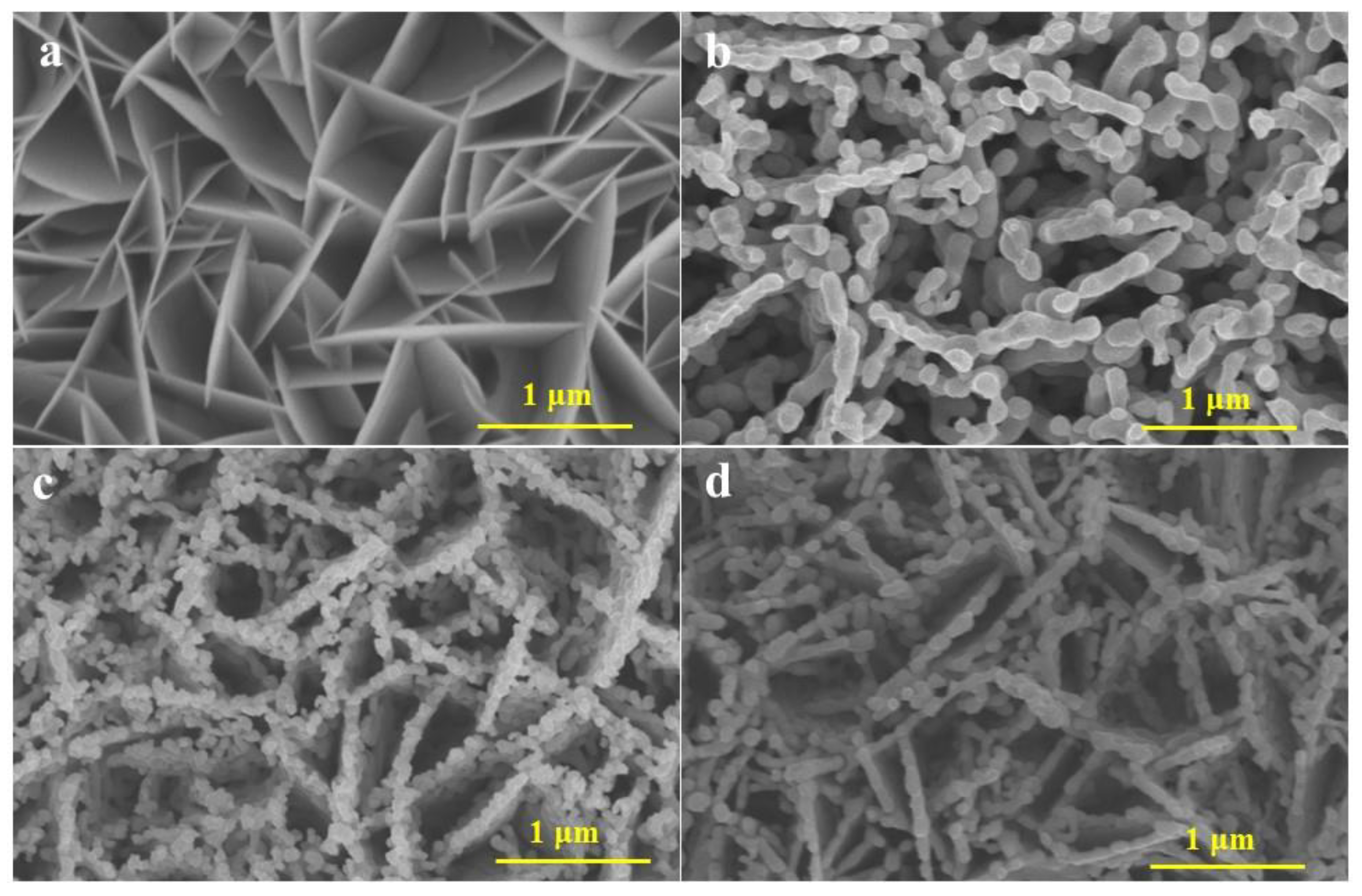

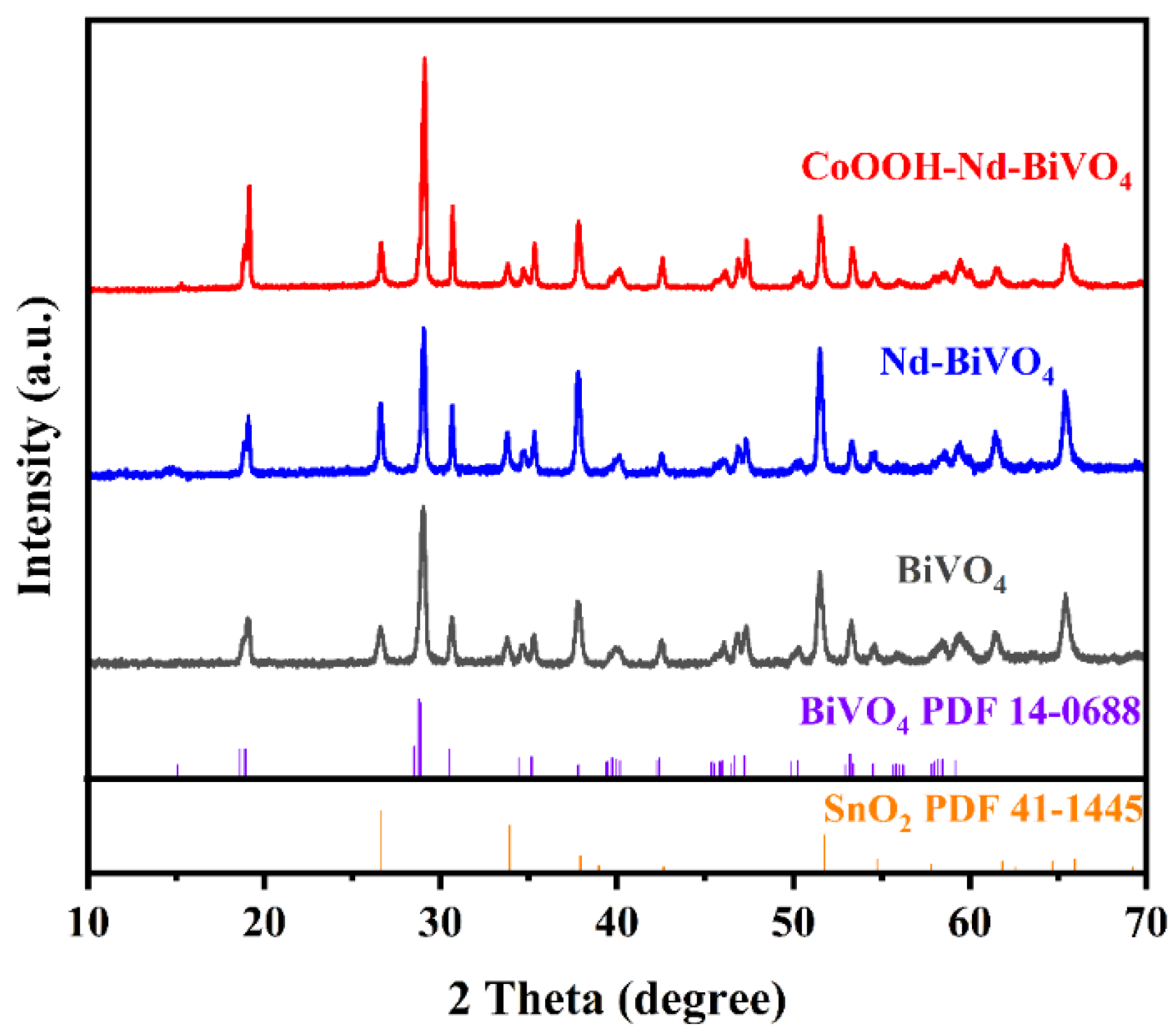
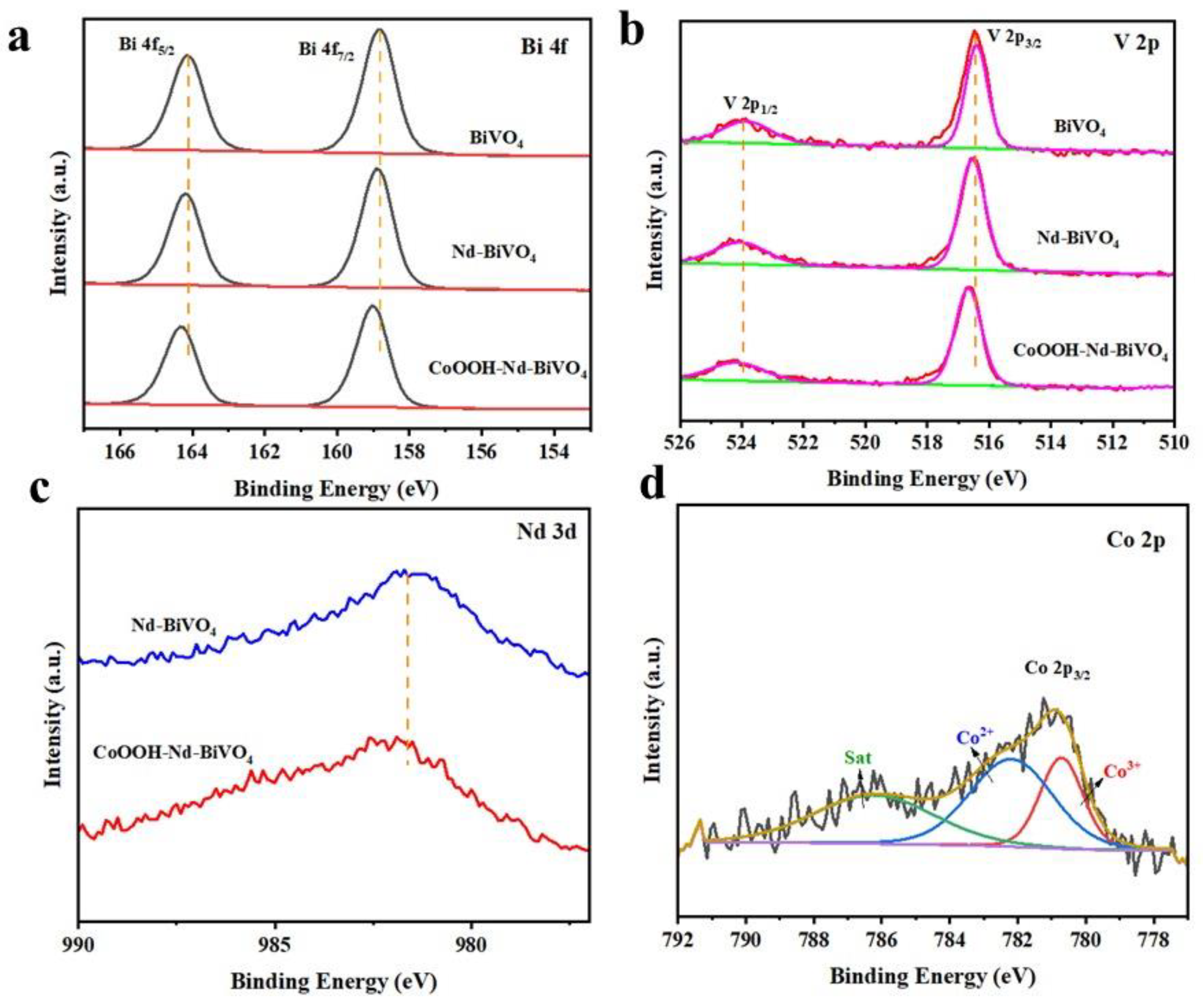
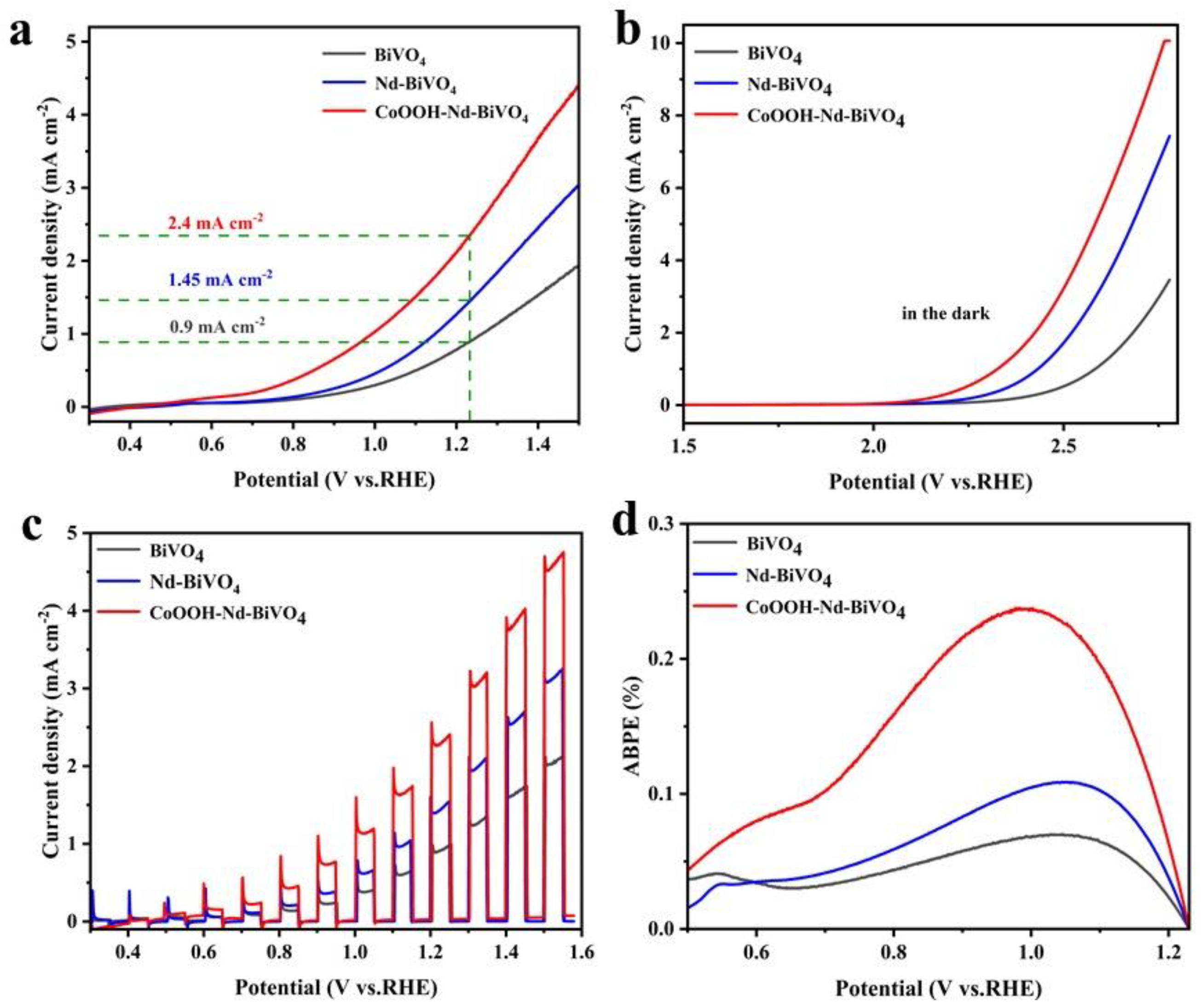
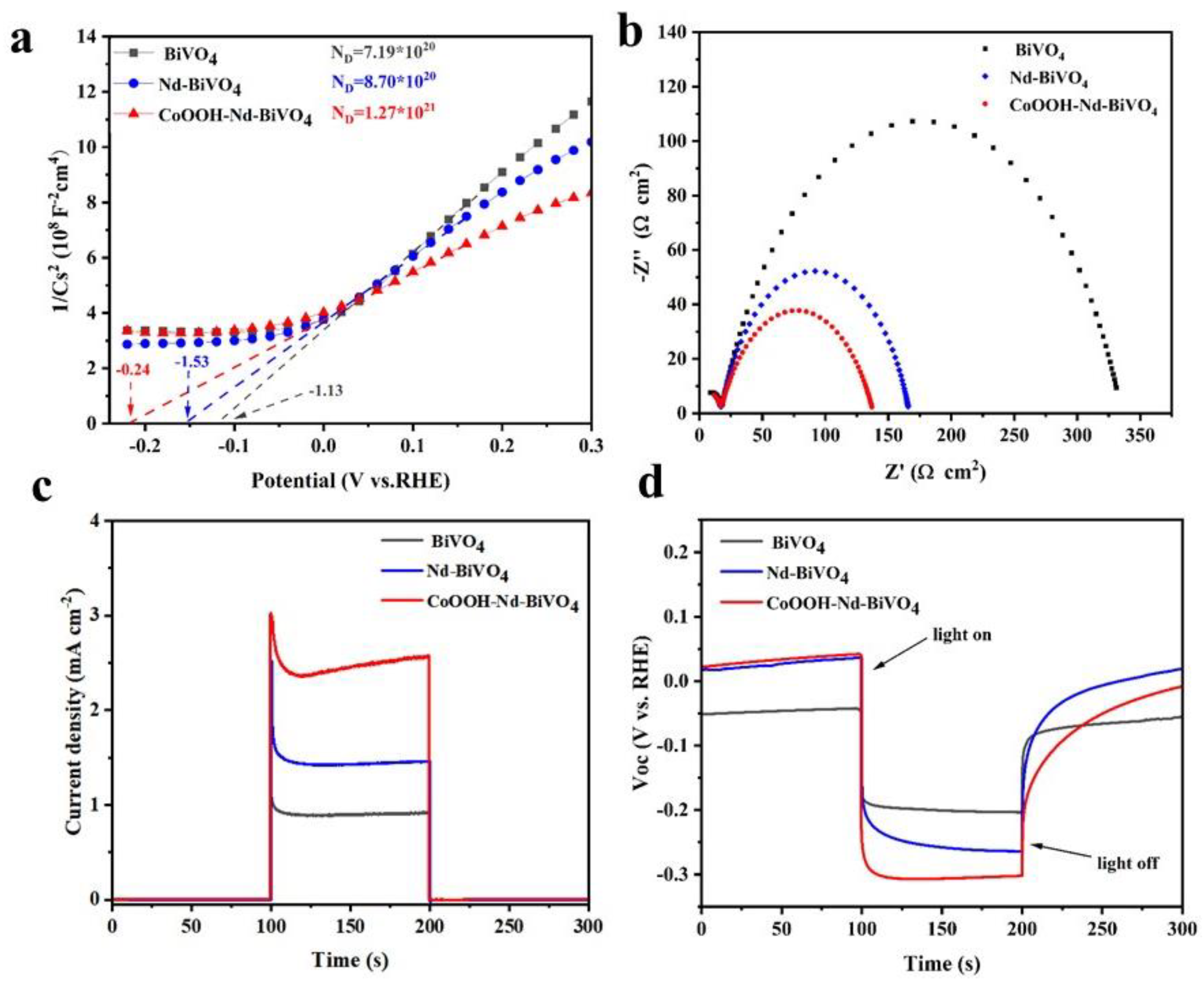
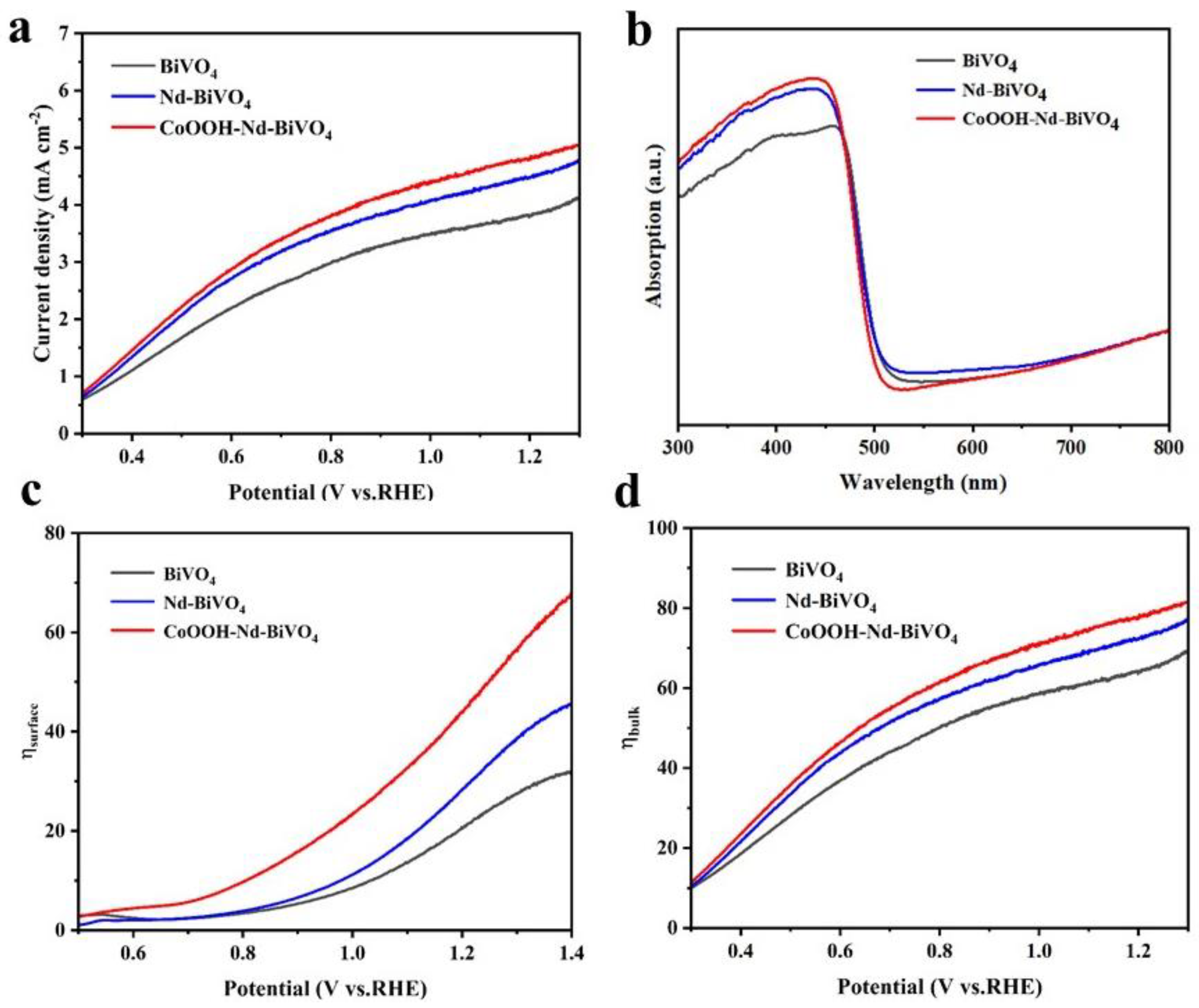


Disclaimer/Publisher’s Note: The statements, opinions and data contained in all publications are solely those of the individual author(s) and contributor(s) and not of MDPI and/or the editor(s). MDPI and/or the editor(s) disclaim responsibility for any injury to people or property resulting from any ideas, methods, instructions or products referred to in the content. |
© 2023 by the authors. Licensee MDPI, Basel, Switzerland. This article is an open access article distributed under the terms and conditions of the Creative Commons Attribution (CC BY) license (https://creativecommons.org/licenses/by/4.0/).
Share and Cite
Wang, M.; Wu, L.; Zhang, F.; Gao, L.; Geng, L.; Ge, J.; Tian, K.; Chai, H.; Niu, H.; Liu, Y.; et al. Doping with Rare Earth Elements and Loading Cocatalysts to Improve the Solar Water Splitting Performance of BiVO4. Inorganics 2023, 11, 203. https://doi.org/10.3390/inorganics11050203
Wang M, Wu L, Zhang F, Gao L, Geng L, Ge J, Tian K, Chai H, Niu H, Liu Y, et al. Doping with Rare Earth Elements and Loading Cocatalysts to Improve the Solar Water Splitting Performance of BiVO4. Inorganics. 2023; 11(5):203. https://doi.org/10.3390/inorganics11050203
Chicago/Turabian StyleWang, Meng, Lan Wu, Feng Zhang, Lili Gao, Lei Geng, Jiabao Ge, Kaige Tian, Huan Chai, Huilin Niu, Yang Liu, and et al. 2023. "Doping with Rare Earth Elements and Loading Cocatalysts to Improve the Solar Water Splitting Performance of BiVO4" Inorganics 11, no. 5: 203. https://doi.org/10.3390/inorganics11050203
APA StyleWang, M., Wu, L., Zhang, F., Gao, L., Geng, L., Ge, J., Tian, K., Chai, H., Niu, H., Liu, Y., & Jin, J. (2023). Doping with Rare Earth Elements and Loading Cocatalysts to Improve the Solar Water Splitting Performance of BiVO4. Inorganics, 11(5), 203. https://doi.org/10.3390/inorganics11050203




